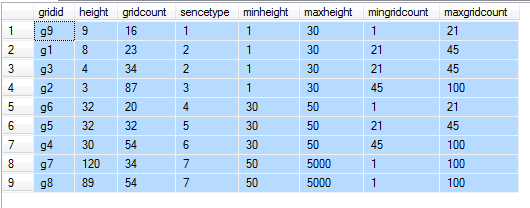Spark:如何替换sc.parallelize(List(item1,item2)).collect().foreach(row=>{})为并行?
代码场景:
1)设定的几种数据场景,遍历所有场景:依次统计满足每种场景条件下的数据,并把统计结果存入hive;
2)已有代码如下:
case class IndoorOTTCalibrateBuildingVecotrLegend(oid: Int, minHeight: Int, maxHeight: Int, minGridIDCount: Int, maxGridIDCount: Int, heightType: Int) extends Serializable // 实例化建筑物区间段:按照栅格的个数(面积)、楼的高度(商场等场景)来划分场景 val buildingHeightLegends = List( IndoorOTTCalibrateBuildingVecotrLegend(1, 1, 30, 1, 21, BuildingCalibrateHeightType.HeightType1.toString.toInt), IndoorOTTCalibrateBuildingVecotrLegend(2, 1, 30, 21, 45, BuildingCalibrateHeightType.HeightType2.toString.toInt), IndoorOTTCalibrateBuildingVecotrLegend(3, 1, 30, 45, 100, BuildingCalibrateHeightType.HeightType3.toString.toInt), IndoorOTTCalibrateBuildingVecotrLegend(4, 30, 50, 1, 21, BuildingCalibrateHeightType.HeightType4.toString.toInt), IndoorOTTCalibrateBuildingVecotrLegend(5, 30, 50, 21, 45, BuildingCalibrateHeightType.HeightType5.toString.toInt), IndoorOTTCalibrateBuildingVecotrLegend(6, 30, 50, 45, 100, BuildingCalibrateHeightType.HeightType6.toString.toInt), IndoorOTTCalibrateBuildingVecotrLegend(7, 50, 5000, 1, 100, BuildingCalibrateHeightType.HeightType7.toString.toInt) ) spark.sparkContext.parallelize(buildingHeightLegends).collect().foreach(buildingHeightLegend => { generateSampleBySenceType(spark, p_city, p_hour_start, p_hour_end, p_fpb_day, p_day_sample, linkLossCalibrateParameter, buildingHeightLegend) })
备注:
在generateSampleBySenceType()函数内部包含有:
spark.sql(s"""
|xxx |where t10.heihgt>=${buildingHieghtLegend.MinHeight} and t10.height<${buildingHieghtLegend.MaxHeight} |and t10.gridcount<=${buildingHieghtLegend.MinGridIDCount} and t10.gridcount>${buildingHieghtLegend.MaxGridIDCount}
|""".stripMargin)
如果把代码修改:
val buildingHeightLegends_df = spark.sqlContext.createDataFrame(buildingHeightLegends) buildingHeightLegends_df.createOrReplaceTempView("temp_buildingheightlegends") sql(s"""|select * from temp_buildingheightlegends""".stripMargin).repartition(buildingHeightLegends.length).foreachPartition(rows => { for (row <- rows) { val buildingHeightLegend = new IndoorOTTCalibrateBuildingVecotrLegend( row.getAs[Int]("oid"), row.getAs[Int]("minheight"), row.getAs[Int]("maxheight"), row.getAs[Int]("mingrididcount"), row.getAs[Int]("maxgrididcount"), row.getAs[Int]("heighttype")) generateSampleBySenceType(spark, p_city, p_hour_start, p_hour_end, p_fpb_day, p_day_sample, linkLossCalibrateParameter, buildingHeightLegend) } })
则会提示:generateSampleBySenceType()内部sql代码位置抛出SparkSession为NULL的异常。
修改方案:
把buildingHeightLegends注册为临时表temp_buildingHeightLegends,去掉外层的foreach,之后在generateSampleBySenceType()内部把temp_buildingHeightLegends与其他结果集合进行cross join:
测试代码如下:
-- 场景表 CREATE TABLE [dbo].[test_senceitems]( [sencetype] [int] NULL, [minheight] [int] NULL, [maxheight] [int] NULL, [mingridcount] [int] NULL, [maxgridcount] [int] NULL ) INSERT [dbo].[test_senceitems] ([sencetype], [minheight], [maxheight], [mingridcount], [maxgridcount]) VALUES (1, 1, 30, 1, 21) INSERT [dbo].[test_senceitems] ([sencetype], [minheight], [maxheight], [mingridcount], [maxgridcount]) VALUES (2, 1, 30, 21, 45) INSERT [dbo].[test_senceitems] ([sencetype], [minheight], [maxheight], [mingridcount], [maxgridcount]) VALUES (3, 1, 30, 45, 100) INSERT [dbo].[test_senceitems] ([sencetype], [minheight], [maxheight], [mingridcount], [maxgridcount]) VALUES (4, 30, 50, 1, 21) INSERT [dbo].[test_senceitems] ([sencetype], [minheight], [maxheight], [mingridcount], [maxgridcount]) VALUES (5, 30, 50, 21, 45) INSERT [dbo].[test_senceitems] ([sencetype], [minheight], [maxheight], [mingridcount], [maxgridcount]) VALUES (6, 30, 50, 45, 100) INSERT [dbo].[test_senceitems] ([sencetype], [minheight], [maxheight], [mingridcount], [maxgridcount]) VALUES (7, 50, 5000, 1, 100) -- 业务过滤统计表 CREATE TABLE [dbo].[test_grid]( [gridid] [nvarchar](50) NULL, [height] [int] NULL, [gridcount] [int] NULL ) INSERT [dbo].[test_grid] ([gridid], [height], [gridcount]) VALUES (N'g1', 8, 23) INSERT [dbo].[test_grid] ([gridid], [height], [gridcount]) VALUES (N'g2', 3, 87) INSERT [dbo].[test_grid] ([gridid], [height], [gridcount]) VALUES (N'g3', 4, 34) INSERT [dbo].[test_grid] ([gridid], [height], [gridcount]) VALUES (N'g4', 30, 54) INSERT [dbo].[test_grid] ([gridid], [height], [gridcount]) VALUES (N'g5', 32, 32) INSERT [dbo].[test_grid] ([gridid], [height], [gridcount]) VALUES (N'g6', 32, 20) INSERT [dbo].[test_grid] ([gridid], [height], [gridcount]) VALUES (N'g7', 120, 34) INSERT [dbo].[test_grid] ([gridid], [height], [gridcount]) VALUES (N'g8', 89, 54) INSERT [dbo].[test_grid] ([gridid], [height], [gridcount]) VALUES (N'g9', 9, 16)
替换generateSampleBySenceType()内部sql(s"""|""".stripMargin)代码类似如下:
select t10.*,t11.* from test_grid t10 cross join test_senceitems t11 where t10.height>=t11.minheight and t10.height<t11.maxheight and t10.gridcount>=t11.mingridcount and t10.gridcount<t11.maxgridcount

基础才是编程人员应该深入研究的问题,比如:
1)List/Set/Map内部组成原理|区别
2)mysql索引存储结构&如何调优/b-tree特点、计算复杂度及影响复杂度的因素。。。
3)JVM运行组成与原理及调优
4)Java类加载器运行原理
5)Java中GC过程原理|使用的回收算法原理
6)Redis中hash一致性实现及与hash其他区别
7)Java多线程、线程池开发、管理Lock与Synchroined区别
8)Spring IOC/AOP 原理;加载过程的。。。
【+加关注】。



